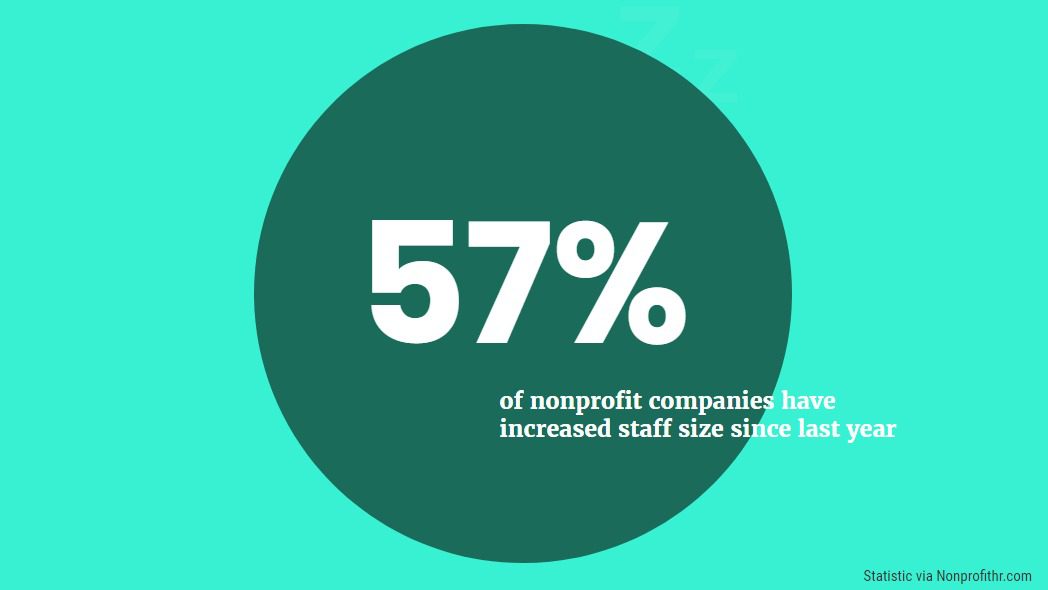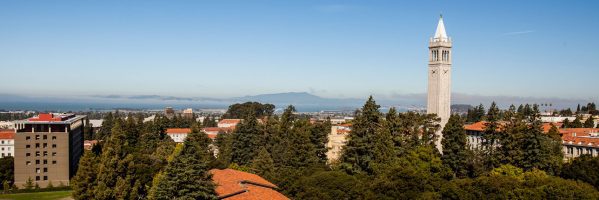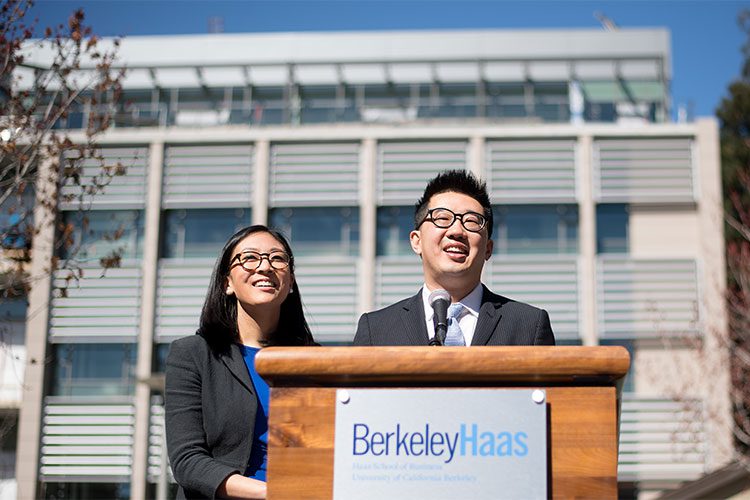Berkeley Haas Celebrates 8 Years of Defining Leadership Principles

If you want to get a feel for the culture of UC Berkeley’s Haas School of Business, look no further than its four Defining Leadership Principles (DLPs): Question the Status Quo, Confidence Without Attitude, Students Always, and Beyond Yourself.
Introduced eight years ago, the DLPs have become a part of the fabric of the school. In fact, 75 percent of students from all three MBA programs and the undergraduate program cite them as a major reason they chose to attend. Not only that, 90 percent of Haas alumni surveyed from the past decade report being familiar with them and using them to navigate both their professional and personal lives. Earlier this month, as part of Haas Culture Day, the school celebrated the DLPs’ eighth birthday, complete with cupcakes.
In an interview with the Haas Newsroom, Dean Rich Lyons talked about the impact the principles he helped introduce have had on the school. “I’d say that we are seeing stronger data every year that the DLPs are affecting what we really care about. For example, we have clear data on how the Defining Leadership Principles are helping us win yield battles (i.e., when students choose Haas over other schools they’ve been admitted to). The DLPs are also motivating our donors. Alumni awareness of the principles is way up, and their engagement based on them is way up.”
To build on these successes, the school has launched a new initiative, the Haas Culture and Leadership Fund, designed to further extend the reach and impact of the DLPs even after Lyons steps down as dean to return to the faculty at the end of this academic year. Among other things, money from the fund will enhance culture-focused content in the curriculum; financial aid, awards, and research support for students and faculty who exemplify the DLPs; and support existing centers and institutes that uphold the principles.
Dean Lyons has a difficult time choosing which DLP most resonates with him. “It has always been hard for me to look at them as anything but a ‘system’ taken all together,” he said. “The one principle that still seems like it sets us apart the most externally versus our top competition is Confidence Without Attitude. But for me personally, the one resonating the most right now is Beyond Yourself. There’s so much in that one that it’s inexhaustible.”
Haas also reached out to its community to find out which DLP they preferred. See what they had to say in the video shared below.
This article has been edited and republished with permissions from our sister site, Clear Admit.
What are the Greenest Business Schools in the U.S.?

Earlier this month, the Global Hub at Northwestern’s Kellogg School of Management earned LEED (Leadership in Energy and Environmental Design) Platinum certification, becoming only the second building on the Northwestern campus to earn the U.S. Green Building Council’s highest green building rating.
The 415,000-square-foot Global Hub, which opened in March 2017, was designed with a low carbon footprint in mind. It is the largest of Northwestern’s 12 LEED-certified buildings. “Achieving LEED Platinum certification for the Global Hub underscores Kellogg’s strong commitment to sustainability,” Kellogg Chief Operating Officer William Garrett said in a press release. “A world-class facility demands world-class practices, and the Global Hub checks all of the boxes: It minimizes its carbon footprint, is comfortable and healthy for its occupants, and encourages collaboration and a sense of community.”
The building is a marvel of modern architecture and design. It taps into geothermal energy systems underneath the ground for efficient heating and cooling and uses nearly 6,000 fixtures of LED lighting to reduce energy use. The building also has an advanced ventilation system to circulate fresh ar and uses daylight sensors to minimize the need for artificial lighting.
Overall, the Global Hub earned 85 out of a possible 110 points on the LEED scale, including:
- 26 out of 35 points for energy and atmosphere,
- 7 out of 14 points for materials and resources,
- 8 out of 10 points for water efficiency,
- 23 out of 26 points for location,
- 11 out of 15 points for indoor environmental quality, and
- 10 out of 10 points for the design process and regional priority categories.
“We are proud to have successfully integrated best-in-class sustainability with a stunning architectural design, proving that excellence in design and sustainability are not mutually exclusive,” said Bonnie Humphrey, director of design for facilities.
Of course, Kellogg isn’t the only business school to embrace environmentally conscious building practices for its new facilities. It’s a practice we’re seeing across the board at various top schools.
For example, Harvard Business School has a Sustainability Plan that was adopted in October 2014 to reduce greenhouse gases, improve energy efficiency, reduce water usage and waste, and more. Already, the university has cut its greenhouse gas emissions by 49 percent, its energy use by 33 percent, and its water use by four percent.
MIT Sloan School of Management’s newest building, the Joan and William A Porter 1967 Center for Management Education, also known as E62, was designed with energy efficiency in mind as well. Among its sustainable features are light-sensitive window shades, a green roof, and an irrigation system that minimizes water use by responding to changes in weather.
And not to be left out, UC Berkeley’s Haas School of Business designed its recently constructed Chou Hall to become the nation’s greenest academic building. In addition to LEED Platinum certification, Chou Hall was designed to attain WELL certification, an added accolade given to buildings that promote user health and well-being. Toward this goal, its design includes rainwater cisterns and 24,300 square feet of exterior windows in addition to efficient heating, cooling, and lighting systems.
This article has been edited and republished with permissions from our sister site, Clear Admit.
New Haas Center Seeks to Tackle Gender, Equity, and Leadership Head On

As one headline after another alleges sexual harassment against women by men in power from Hollywood to Congress, the launch earlier this month UC Berkeley’s Haas School of Business of a new Center for Gender, Equity, and Leadership (CGEL) seems more timely than ever. In fact, the idea for the center significantly predated the current media firestorm—and while its scope will certainly include sexual harassment, it will be significantly wider—addressing issues ranging from the persistent gender pay gap to inadequate maternity leave to the fact that currently only 5.6 percent of CEOs at S&P 500 companies are women.
Since 2014, Kellie McElhaney has been teaching a course at Haas called “The Business Case for Investing in Women.” Regularly over-subscribed, the immensely popular class won McElhaney, an associate adjunct professor at Haas, the Earl F. Cheit Award for Excellence in Teaching. Students in the class were eager for data demonstrating that companies with greater numbers of women in leadership have higher share prices and better returns on equity and investment than companies with fewer women. In fact, so too were companies. And McElhaney delivered.
Together in a 2016 study with Genevieve Smith of the International Center for Research on Women’s advisory practice, McElhaney zeroed in on how Gap Inc. has managed to achieve pay equity at the like-for-like level and equal pay at the organizational level through its company culture, practices, and policies. The relationships that helped spur that research also led the Gap Foundation to become a founding corporate donor of the new center—contributing part of the $1.9 million McElhaney has raised to date, which also includes gifts from alumni and friends. With an ultimate fundraising goal of $10 million, McElhaney hopes CGEL will bring together leaders from many backgrounds to help advance gender and diversity in policy and business, engage male and female allies and people of all ethnicities, races, and classes around a shared goal of gender and diversity, and develop business leaders who view gender as a spectrum rather than a binary construct.
“The idea for the center has been percolating for years,” McElhaney tells Clear Admit. “We had kind of a scatterplot of things happening at Haas before, but no over-arching strategy.” In addition to McElhaney’s own research and teaching, several other Haas professors have been contributing to growing scholarship on gender, equity, and leadership. Professor Laura Tyson’s research and writing has examined how gender equity works around the globe—including how it is associated with better education and health, higher per capita income, faster and more inclusive growth, and greater international competitiveness. Currently faculty director of the Haas Institute for Business & Social Impact, Tyson will form part of the leadership team of CGEL. Professor Laura Kray, who studies gender stereotyping and negotiations, rounds out the inaugural CGEL leadership team.
“The first mission of the center will be to serve as a hub for all the things that have already been happening in pockets all over Haas,” says McElhaney. “There are already courses on power, race, gender, equity,” she explains. “In earnest, we thought to ourselves, ‘Let’s look at all that is happening here around these issues. Wouldn’t it be more effective if we could bring it all together, see what we are doing, and see where we might benefit from going long and deep?”
“At Berkeley, you can build anything—but it has to be funded first,” explains McElhaney. Encouraged by Dean Richard Lyons, she set out to raise $1 million by July 2017 as a proof of concept. In June, CGEL had garnered $1.2 million in funds. In addition to corporate funding from Gap, McElhaney also wooed significant gifts from several high-net-worth individuals through a series of strategic luncheons focused on looking at the world vis-à-vis gender equity. “A dozen individuals gave money right away, and now we’re heavy into the corporate funding component,” she explains.
Expanded Faculty Research, Policy Impact, Radical Fierce Ally-ship
Beyond continued fundraising, McElhaney intends to start 2018 with content and substance—with CGEL serving as a hub for new in-depth faculty research, corporate collaboration, conferences, training sessions, and the development of new courses related to gender, equity, and leadership. In addition to McElhaney’s own work documenting the business case for gender equity, several other Haas professors have also been engaged in pathbreaking research. For example, Professor Clayton Critcher has studied the multiple negative consequences of concealing one’s sexual orientation at work; CGEL leadership team member Kray’s recent work examines how fixed beliefs about gender roles preserve the status quo; and Professor Jennifer Chatman has helped reveal how political correctness in the workplace reduces uncertainty in relationships, encouraging greater creativity by both men and women.
Another point of focus for CGEL will be on the intersection between policy and business. “We want to bring together political and business leaders to look at the things on the political agenda that are moving us backward and how we prioritize them,” McElhaney says, offering pay data transparency and mandatory maternity leave as two examples. “We need to bring business voices into the political fold.”
Developing “radical fierce allies” will be another key priority for the center, she continues. “Men need to come to the table in terms of being ambassadors, but so, too, do women,” McElhaney stresses. “As a white woman, I am earning 80.5 cents on the dollar compared to my male counterpoints, but if I were an African-American woman, that would be 60 cents.” The center will host strategically curated salons to talk about all of these issues, drawing together women of all races, classes, and gender identities to talk about how all women need to be better allies for one another.
CGEL’s Time Is Now
Dean Lyons notes that center’s launch is well timed. “The majority of CEOs include gender equity among their Top 10 priorities, yet boardrooms and C-suites are not changing quickly enough,” he on the Haas website. “While the commitment to diversity and an inclusive work environment is there, too few have a handle on solutions. Our new center will work toward immediate change in these areas and pave the way for future generations.”
McElhaney agrees. “We have a ton of traction, and the appetite is so high for this,” she says. But not only are they hitting it at the right time, but also at the right place, which is Haas. “We have just the right mix of ingredients that other schools can’t claim,” she says. “While other schools are focusing more on diversity or counting the heads, we are focused comprehensively on inclusion in our classrooms—through our cases, our choice of course speakers, our faculty teaching methodology, and our student culture.”
CGEL’s launch will help ensure that Haas students hear about gender, equity, and leadership in every class. “This is a new center that puts on the map that this is something we care about,” she says. “We graduate 100 leaders every year—and going forward we are going to graduate 100 diversity fluent leaders. I think we are uniquely positioned to become a talisman of all things equity.”
Learn more about Haas’s new Center for Gender, Equity and Leadership.
This article has been edited and republished with permissions from Clear Admit.
In Search of San Francisco’s Best Nonprofit MBA Programs

Even though San Francisco may be thought of as the place to be for entrepreneurship and technology, the city is home to a diverse community of organizations both private and public, both for and not-for-profit.
Business professionals in the city can apply their business acumen and education in a number of ways, whether helping a new venture get on its feet, contributing to some of the largest tech firms in the world, or supporting a mission they’re passionate about. And though such mission-driven organizations center around the cause and not of profit-making, having a strong business leader at the helm is crucial in helping these organizations to achieve their mission.
Students interested in gaining critical operations and management skills to apply in the nonprofit sector may be interested in pursuing an MBA in Nonprofit Management. Professionals with this degree have moved on into major leadership roles in the nonprofit field, whether working as a Nonprofit Program Director, Development Director, or Community Outreach Coordinator. Nonprofit managers are able to flex their muscles in finance, marketing and a number of other areas of business while still focusing their passion on a broader mission of change or aide.
A few business schools in the San Francisco metro area offer the chance for students to focus their MBA in the field of Nonprofit Management, offering a diverse skill set of nonprofit experience combined with a strong business foundation. Below, you can explore the San Francisco MBAs in Nonprofit Management.
San Francisco Nonprofit MBA Programs You Need To Know
Haas School of Business – UC Berkeley
The Haas School of Business at UC Berkeley offers an MBA concentration in Social Sector Leadership through the university’s Center for Social Sector Leadership. Ranked second overall among business schools with a nonprofit focus by U.S. News & World Report, the Haas program trains up-and-coming business leaders to make a social impact and inspire collaboration between sectors.
The Center for Social Sector Leadership offers students a wide variety of courses to take that can help shape various careers in the social sector, such as nonprofit consulting, board leadership, and strategic or financial nonprofit management. In addition to learning inside the classroom, the center also provides a number of opportunities for experiential learning, such as the Berkeley Board Fellows, which places graduate students on nonprofit boards of directors, or the Haas Impact Investing Network, which offers first-hand experience in impact investing for socially-minded MBAs around the country.

San Francisco State University College of Business
The College of Business at San Francisco State University offers at MBA Emphasis on Nonprofit and Social Enterprise Leadership. With the goal of preparing students to take their business skills to mission-driven organizations, the program will teach students to create a coherent organizational vision, apply innovative solutions to address needs, and evaluate the effectiveness of an organization’s programs in meeting goals.
Students in the Nonprofit and Social Enterprise Leadership emphasis will take the core MBA course requirements as well as three courses for their major: Nonprofits, Policy and Society; Innovation for Sustainability; and Seminar in Social Entrepreneurship, or Strategies in Emerging and Developing Economies. Students will also select two electives that can help further shape their education in leadership and creativity.
Stanford University Graduate School of Business
The Stanford Graduate School of Business offers MBA students the opportunity to pursue a Certificate in Public Management and Social Innovation as part of their degree. Through the university’s Center for Social Innovation, MBA students can explore the social sector and prepare for roles as forces for social change throughout the nonprofit, philanthropic, government, or corporate spheres.
To pursue the certificate, MBA students must complete a social innovation experience that allows them exposure to populations affected by a particular social or environmental issue. Students may also work alongside leaders making contributions in the field to fulfill the requirement.
For more on how MBAs are making a greater social impact, check out how these students are making a difference in their own unique way.
Top MBA Programs for Producing Founders: 2017-2018 Report

Recently, PitchBook released its latest 2017-2018 Top 50 Universities Report. The ranking focused on those universities that produced the “ultimate building blocks of the venture industry: founders.”
This ranking is vastly different from rankings of top schools for entrepreneurship by U.S. News & World Report, Princeton Review, and Entrepreneur Magazine, all of which focus on factors like peer assessment surveys, curriculum, and entrepreneurial study options. Instead, PitchBook looked at a single criterion: founders of companies who received venture capital (VC) funding between January 1, 2006, and August 18, 2017, and where they went to school.
The report provides a fairly detailed breakdown of top undergraduate programs, companies (by capital raised), MBA programs, female founders, unicorns (companies that have attained the coveted $1 billion evaluation), and more. This article will focus solely on the results that relate to MBA programs, including information on female founders and unicorns.
Top MBA Programs
For the 2017-18 academic year, the top 10 MBA programs to produce founders who received VC funding were ranked as follows:
- Harvard Business School (HBS): 1,203 entrepreneurs, 1,086 companies, and $28,495 million raised
- Stanford Graduate School of Business (GSB): 802 entrepreneurs, 716 companies, and $18,259 million raised
- University of Pennsylvania’s Wharton School: 666 entrepreneurs, 585 companies, and $16,001 million raised
- INSEAD: 455 entrepreneurs, 406 companies, and $7,795 million raised
- Northwestern’s Kellogg School of Management: 445 entrepreneurs, 417 companies, and $5,680 million raised
- Columbia Business School: 441 entrepreneurs, 410 companies, and $5,465 million raised
- MIT Sloan School of Management: 437 entrepreneurs, 384 companies, and $7,797 million raised
- University of Chicago Booth School of Business: 405 entrepreneurs, 368 companies, and $5,470 million raised
- University of California – Berkeley Haas School of Business: 344 entrepreneurs, 314 companies, and $5,191 million raised
- UCLA Anderson School of Management: 247 entrepreneurs, 232 companies, and $3,957 million raised
HBS stands out immediately for producing founders who receive VC funding. Harvard produced twice as many founders as its next closest competitor, and those founders pulled in $10M more in funding for their 1,000+ companies.
As for the reason behind Harvard’s success, there are multiple elements that contribute to its production of entrepreneurs. The school is home to the Arthur Rock Center for Entrepreneurship, which offers programs for budding entrepreneurs including curricular offerings (over a dozen courses), a New Venture Competition (which offers $300,000 in cash prizes), the Rock Accelerator, the Harvard Innovation Lab, and even a Loan Reduction program that supports graduating entrepreneurs with a one-time, need-based award of $10,000 to $20,000. HBS’s extensive alumni network also provides students with connections with managing directors, partners, and founders of top VC firms including Bain Capital Ventures, Apax Partners, and Accel Partners.
Another standout for the 2017-2018 year was INSEAD. The only non-U.S. MBA program to appear in the top 10, it also moved up a spot this year over last. INSEAD grew from 393 entrepreneurs, 348 companies, and $6,131 million in capital raised to 455, 406, and $7,794 million respectively.
INSEAD’s students are supported by the INSEAD Centre for Entrepreneurship (ICE), which was founded in 2003. The center offers MBA students a chance to participate in the INSEAD Venture Competition (IVC), Entrepreneurship Bootcamps, and the Entrepreneurship Teaching Innovation (ETI) Fund, which supports the development of the “Your First Hundred Days” elective for budding entrepreneurs.
Another MBA program of note is MIT Sloan School of Management, which was fourth in capital raised on this year’s PitchBook ranking. This could indicate more successful companies coming out of MIT or a higher percentage of VC funding available to Massachusetts’ graduates.
Some of the unique entrepreneurship opportunities available from other top programs include Stanford GSB’s Startup Garage, an intensive, hands-on project course for MBA students, as well as MIT Sloan’s Martin Trust Center for MIT Entrepreneurship, which includes an accelerator, coaching, and various events. Finally, the Penn Wharton Entrepreneurship Center offers resources, events, and courses for MBAs looking to explore, develop, launch, and scale a startup.
Top Female Founders & Unicorns
PitchBook also reviewed the top MBA programs for female founders. Once again, HBS and Stanford GSB ranked first and second, respectively, with 202 and 119 female founders. Columbia Business School ranked third with 77, Wharton ranked fourth with 71, and MIT came in at fifth with 60 female founders.
As for the unicorns, the top five MBA programs are similar to the previous lists.
- HBS: 22 entrepreneurs, 17 companies
- Stanford GSB: 14 entrepreneurs, 11 companies
- Wharton: 11 entrepreneurs, 8 companies
- INSEAD: 8 entrepreneurs, 7 companies
- MIT Sloan: 6 entrepreneurs, 6 companies
This article has been edited and republished with permissions from Clear Admit.
Berkeley Haas Opens Fall 2017 With Its Largest Full-Time MBA Class Ever and New Building

Like many top business schools this time of year, the Haas School of Business at the University of California at Berkeley is welcoming its incoming class of MBA students—but at Haas it’s a bigger group than ever before moving into brand-new digs that promise to be among the greenest in the nation.
There are 284 students in the entering class—32 more than last year—which brings what has long been the smallest leading business school more in line with some of its peers. Plans for next year include additional expansion, to a class size of 300. The grand opening of a new academic building—in progress for the past decade—made increasing the class size possible.
“The intimacy of the class is really an important part of what Haas is about,” Dean Richard Lyons acknowledged in a June interview with Clear Admit. But at just 250 students, where the school has hovered for many years, it has been a gross outlier—a mere third the size of Wharton and not even a third the size of Harvard. “Part of the reputation of the school is a function of its scale, and there are times where you are just not at the right reputational scale—you’re too small,” Lyons continued. “It’s a super intimate experience—there’s no question about that—but target companies want to go to a place where there are enough people graduating that they can send a team of recruiters, for example. If you are too small you are below the threshold.”
“We Don’t Want to Lose the Smallness That Makes Us Unique”
Precisely because the intimacy and close-knit nature of Haas is such an integral part of its culture, the administration, including the admissions team, has approached the process of increasing the class size carefully and thoughtfully. “I think people would be surprised by the amount of care that has been taken to consider potential ramifications,” Peter Johnson, assistant dean for the full-time MBA program and admissions, tells Clear Admit, adding that his team considered necessary adjustments of everything from budgets to graduate student instructors, program office staff to career coaches. “We have been very intentional about it because we don’t want to lose the level of smallness that makes us unique. A lot of our students were very concerned that it not change the experience for future students.”
Not only is the incoming class larger than any before it, it is also one of the strongest academically, Johnson says. Average GMAT scores and GPAs have risen over each of the past three years. The average GMAT score this year was 725—a jump from last year’s 717—and the average GPA climbed, too, from 3.64 to 3.71. Application volume also increased this past year, which meant that though the school admitted more students overall to increase class size, the acceptance rate remained constant at 12 percent. HBS, by comparison, generally accepts approximately 11 percent of its applicants.
The incoming class includes 40 percent women, up slightly over last year though still off from the record 43 percent that made up the Class of 2016. International students drawn from 42 different countries make up 39 percent of the class, up from 38 percent last year. Haas leads HBS, Wharton, and Kellogg in this metric, whose incoming classes are all around 35 percent international. Despite concerns that talk of potential immigration and visa reform under the current administration could have a chilling effect on international application volume, applicants from abroad applied in equal numbers this year as last, Johnson notes. U.S. minority students comprise 29 percent of the class, down from 32 percent last year.
In terms of what they did before coming to Haas, members of the Class of 2019 are an incredibly interesting bunch. Among them are a business development manager from Intel who led development of Google’s self-driving cars, an investment banker who ran from San Francisco to New York City over the summer to raise money and awareness of ALS in honor of his grandmother, a Bain consultant who earned four culinary diplomas in her spare time, a student from Nepal who helped senior political leaders and ex-ministers from five major parties negotiate a new constitution, and the founder and CEO of an Indian irrigation company that saves 4 billion liters of water annually while enabling smallholding farmers to produce 10,000 additional tons of food per year.
A quarter of the incoming students worked in consulting prior to Haas, and another 20 percent worked in finance. In terms of undergraduate degrees, 42 percent studied business or economics, 36 percent hold STEM degrees, and 8 percent graduated with degrees in the humanities.
“Top students from around the world with diverse backgrounds and amazing accomplishments continue to choose us for our distinctive culture,” Morgan Bernstein, executive director of full-time MBA admissions, said as part of an article on the Haas website. “No one else has the culture and community that we do.”
Can Chou Hall be the Greenest Academic Building in the U.S.?
The Haas Class of 2019 is the first to inhabit the newly opened Connie & Kevin Chou Hall, an 80,000-square-foot facility that boasts state-of-the-art classroom technology, flexible learning spaces, and features such as efficient heating, cooling, and lighting systems. These, in addition to rainwater cisterns and 24,300 square feet of exterior windows, helped it earn both LEED Platinum certification and WELL certification (an additional accolade applied to buildings that promote the health and well-being of their users).

Kevin Chou and Dr. Connie Che appearing at the Berkeley Haas School of Business last March, after announcing their record-breaking school donation (Noah Berger/2017)
The building bears the name of Kevin Chou, BS ’02, founding CEO of mobile gaming company Kabam, and his wife, Dr. Connie Chen, in recognition of their $25 million donation, the largest to date from an under-40 alum. The remaining funds for the $60 million building also came entirely from alumni and friends of the school.
In addition to LEED Platinum and WELL certification, Chou Hall has been designed to divert 90 percent of waste—including through the mandatory use of reusable mugs and water bottles that can be replenished at filling stations and compost and recycling bins on every floor—which will allow it to achieve zero waste certification by summer 2018. This would make it the first business school in the country to do so.

Early-stage concept art for the Connie & Kevin Chou Hall.
There are no places to dispose of other types of trash—encouraging those who use the building to adopt a “’pack-it-in, pack-it-out’ mentality,” according to Courtney Chandler, senior assistant dean and chief strategy and operations officer. “It might take a little getting used to, but we don’t think it will be hard for the Haas community—we’re all about questioning the status quo and redefining business-as-usual,” Chandler said in a story on the Haas website, referring to two of the school’s defining principles.
The building includes eight tiered classrooms and four flexible classrooms, totaling 858 new classroom seats, as well as 28 student and meeting rooms. This provided the much-needed additional space Haas required to expand its class size. A sixth-floor event space will open next month, and a café offering sustainable, locally sourced food—what else—is slated to begin serving students in early 2018.
This article has been edited and republished with permissions from Clear Admit.
